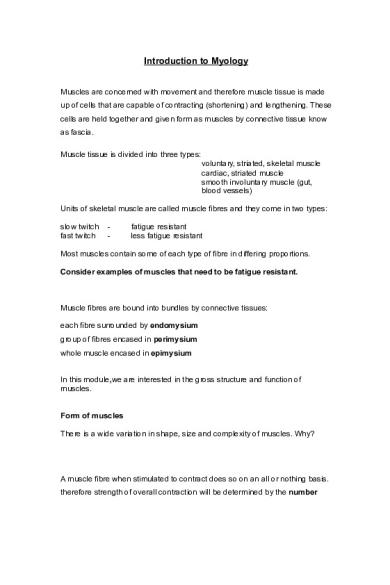Introduction to Myology copy PDF

| Title | Introduction to Myology copy |
|---|---|
| Course | applied anatomy |
| Institution | University of the West of England |
| Pages | 3 |
| File Size | 68.3 KB |
| File Type | |
| Total Downloads | 64 |
| Total Views | 174 |
Summary
Download Introduction to Myology copy PDF
Description
Introduction to Myology
Muscles are concerned with movement and therefore muscle tissue is made up of cells that are capable of contracting (shortening) and lengthening. These cells are held together and given form as muscles by connective tissue know as fascia. Muscle tissue is divided into three types: voluntary, striated, skeletal muscle cardiac, striated muscle smooth involuntary muscle (gut, blood vessels) Units of skeletal muscle are called muscle fibres and they come in two types: slow twitch fast twitch
-
fatigue resistant less fatigue resistant
Most muscles contain some of each type of fibre in differing proportions. Consider examples of muscles that need to be fatigue resistant.
Muscle fibres are bound into bundles by connective tissues: each fibre surrounded by endomysium group of fibres encased in perimysium whole muscle encased in epimysium In this module,we are interested in the gross structure and function of muscles. Form of muscles There is a wide variation in shape, size and complexity of muscles. Why?
A muscle fibre when stimulated to contract does so on an all or nothing basis. therefore strength of overall contraction will be determined by the number
and size of the muscle fibres. The effective range of the movement which a muscle can provide is determined by the length of its fibres. Where muscle fibres are arranged in parallel, muscles may be quadrilateral, fusiform or straplike. Here maximum contraction of the fibres pulls in the same direction. Muscles whose fibres are arranged obliquely to the line of pull may be triangular or pennate. Here we see division of the pull into two components, one along the line of pull and one at right angles to the line of pull, resulting in decreased range of movement but increased power. These forms of muscle have increased numbers of muscle fibres compared to those straplike / fusiform muscles.
Pennate muscles can be further divided into: Unipennate
tendon of insertion extends upwards along one border of the muscle
Bipennate
tendon up through the middle of the muscle
Multipennate insertion
number of extensions pass up through the tendon of
*Please refer to The Anatomy Workbook by Stuart Porter pages 15-17 The fibrous tissue network helps to control effective direction of muscle force and supports blood vessels and nerves supplying the muscle. It also reduces friction between muscles on contraction reducing heat production. Muscle attachment to bone is via: Tendons continuous with the fibrous network and largely composed of collagen fibres. They are highly resistant to stretch but relatively flexible enabling them to be angled around bony points to influence direction of pull. Tendons usually take the form of cords or straps being round, oval or elongate in cross section. Their tensile strength is similar to bone although only slightly extensile they are elastic. On muscular contraction much of the contractile
force is transferred to the tendon. Tendons have a relatively poor blood supply. Aponeuroses are flat sheets of densely arranged collagen fibres allowing attachment to bone over a wide area. Fibrous tissue has a lower oxygen requirement than muscle tissue. Tendons and aponeuroses transmit the force of the muscle to bone and frequently pull out impressons on the bone as a result. Occasionally muscle fibres can attach directly to smooth bone. Further directed reading: Gray’s Anatomy 36 th Edition Chapter 5 Myology. Attachments, general form and actions of skeletal muscle. Pg. 522-529 (Page numbers may vary within different editions).
General principles re- muscles: Muscles closest to a joint are shortest in length Larger the muscle the more coarse are the fibres – strength The longer the muscle the greater the range of movement through which it can perform
How to study a muscle Note its position, shape, size, morphology and general relationships. Describe the attachments -
distal proximal
Describe the direction of fibres from proximal to distal attachment What are its actions? How does it contribute to functional activities of daily living Nerve supply? How do we demonstrate the contraction of the muscle?...
Similar Free PDFs

Introduction to Myology copy
- 3 Pages

Myology - Lecture about muscles
- 4 Pages

Ladder. 1. introduction copy
- 6 Pages

Introduction to
- 22 Pages

Introduction to Ninth Edition Introduction to
- 1,073 Pages

Drugs to remember copy
- 16 Pages

Introduction to Cakes Homework
- 42 Pages

Introduction-to-project-management
- 36 Pages

Introduction to Capacitors
- 11 Pages

Introduction to Ecommerce
- 9 Pages
Popular Institutions
- Tinajero National High School - Annex
- Politeknik Caltex Riau
- Yokohama City University
- SGT University
- University of Al-Qadisiyah
- Divine Word College of Vigan
- Techniek College Rotterdam
- Universidade de Santiago
- Universiti Teknologi MARA Cawangan Johor Kampus Pasir Gudang
- Poltekkes Kemenkes Yogyakarta
- Baguio City National High School
- Colegio san marcos
- preparatoria uno
- Centro de Bachillerato Tecnológico Industrial y de Servicios No. 107
- Dalian Maritime University
- Quang Trung Secondary School
- Colegio Tecnológico en Informática
- Corporación Regional de Educación Superior
- Grupo CEDVA
- Dar Al Uloom University
- Centro de Estudios Preuniversitarios de la Universidad Nacional de Ingeniería
- 上智大学
- Aakash International School, Nuna Majara
- San Felipe Neri Catholic School
- Kang Chiao International School - New Taipei City
- Misamis Occidental National High School
- Institución Educativa Escuela Normal Juan Ladrilleros
- Kolehiyo ng Pantukan
- Batanes State College
- Instituto Continental
- Sekolah Menengah Kejuruan Kesehatan Kaltara (Tarakan)
- Colegio de La Inmaculada Concepcion - Cebu





